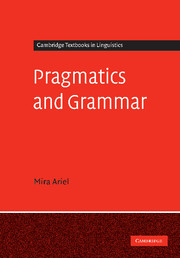Book contents
- Frontmatter
- Contents
- List of tables
- Preface
- Acknowledgments
- How to use this book
- Transcription conventions
- 1 Introduction: Grammar, pragmatics, and what's between them
- PART I Drawing the grammar/pragmatics divide
- 2 Distinguishing the grammatical and the extragrammatical: referential expressions
- 3 Distinguishing codes, explicated, implicated, and truth-compatible inferences
- PART II Crossing the extralinguistic/linguistic divide
- Part III Bringing grammar and pragmatics back together
- References
- Author index
- Subject index
2 - Distinguishing the grammatical and the extragrammatical: referential expressions
Published online by Cambridge University Press: 05 September 2012
- Frontmatter
- Contents
- List of tables
- Preface
- Acknowledgments
- How to use this book
- Transcription conventions
- 1 Introduction: Grammar, pragmatics, and what's between them
- PART I Drawing the grammar/pragmatics divide
- 2 Distinguishing the grammatical and the extragrammatical: referential expressions
- 3 Distinguishing codes, explicated, implicated, and truth-compatible inferences
- PART II Crossing the extralinguistic/linguistic divide
- Part III Bringing grammar and pragmatics back together
- References
- Author index
- Subject index
Summary
The code/inference definition for the grammar/pragmatics divide places quite a few so-called pragmatic phenomena on the grammar side of the fence. Whenever we observe a conventional correlation between some form and some function we classify the interpretation or use conditions involved as encoded (see also Ariel, forthcoming; Prince, 1988). Whether the function is truth-conditionally relevant or not is immaterial. (This is in sharp contrast with the Gricean classification of conventional implicatures as pragmatic.) But how do we establish that the association at hand is conventional? How can we tell that some interpretation is an inference? Cases where functions can be inferred are pragmatic; cases where inference cannot be invoked must be stipulated as grammatical. But, as will become clear in chapter 2, at least in some cases, it is far from trivial to determine whether the form–function association at hand is conventional or inferred. Even the fact that we can derive some interpretation as an inference does not mean that inferring is actually the means by which interlocutors arrive at the relevant interpretation. Part II later provides an explanation for this phenomenon: recurrent inferences may (gradually) turn into codes. This means that there are bound to be borderline cases.
Referential expressions, mostly definite descriptions and pronouns, have been chosen as subject matter for addressing these questions in chapter 2. We shall discuss three phenomena pertaining to referring expressions. Regarding the first one, presuppositions (section 2.1), the literature has been divided about assigning it grammatical (semantic) versus pragmatic status.
- Type
- Chapter
- Information
- Pragmatics and Grammar , pp. 27 - 67Publisher: Cambridge University PressPrint publication year: 2008



